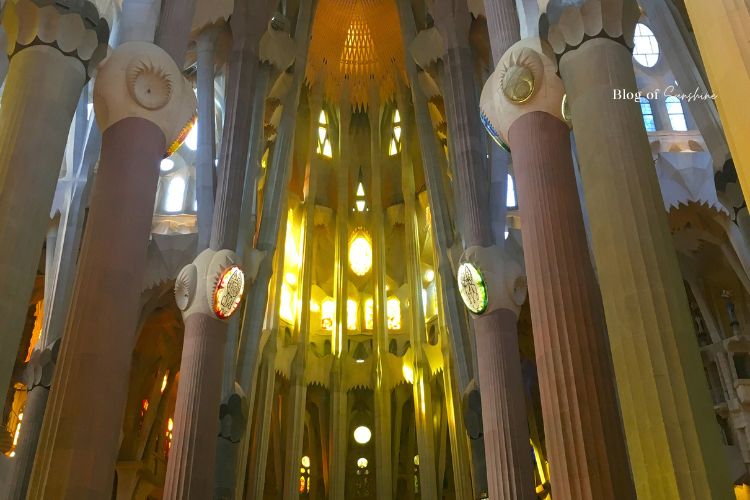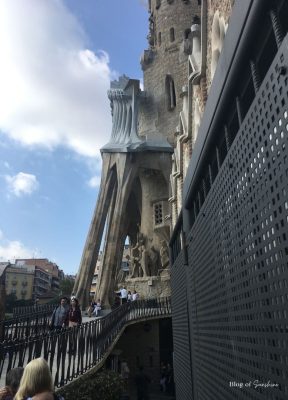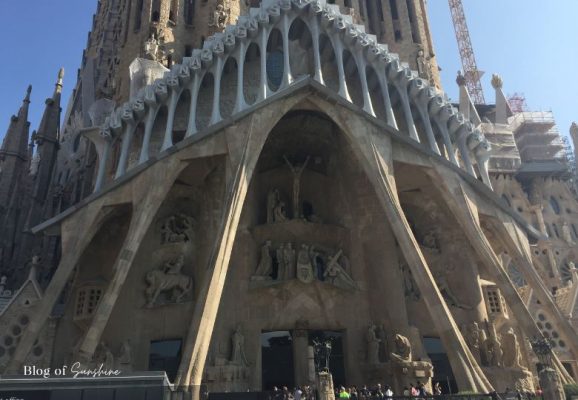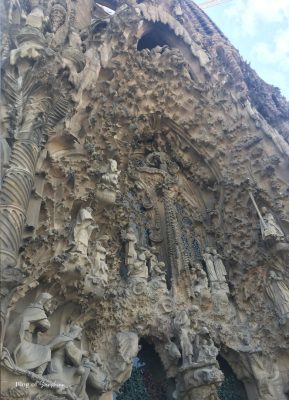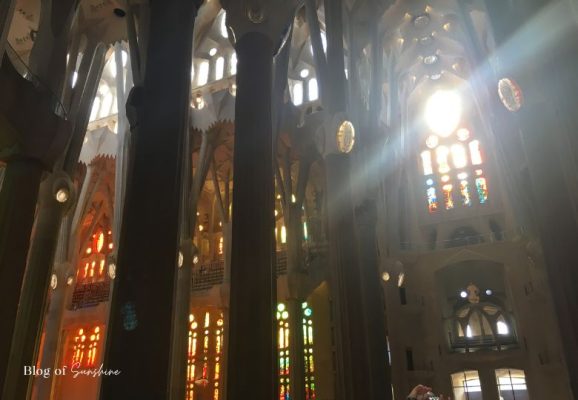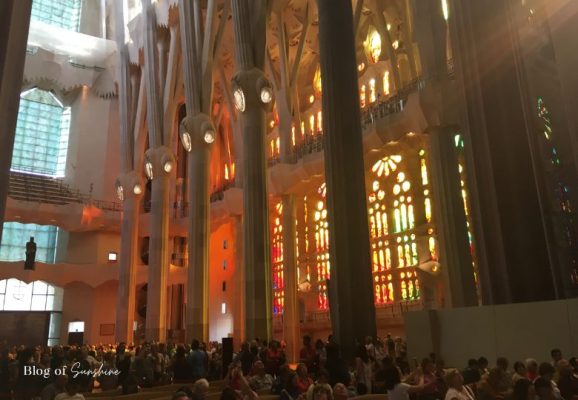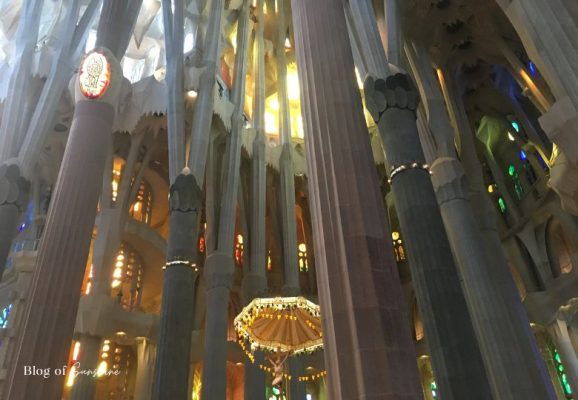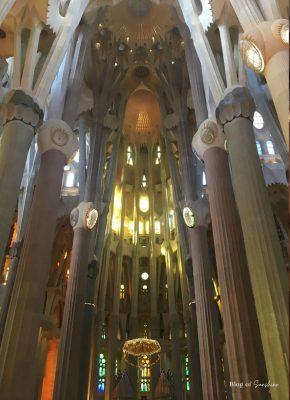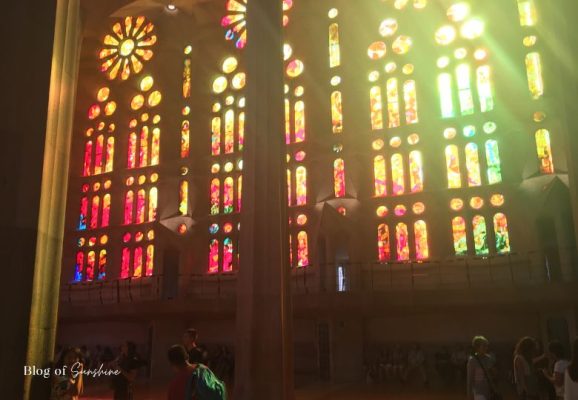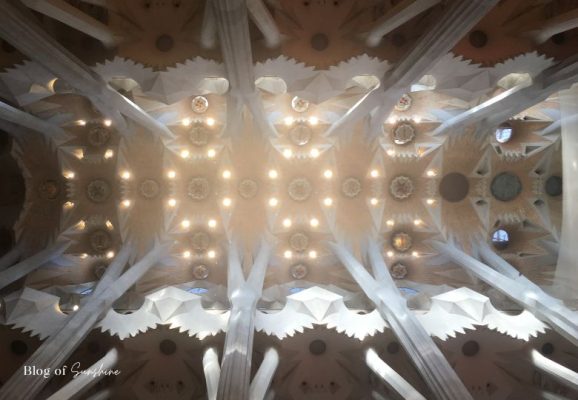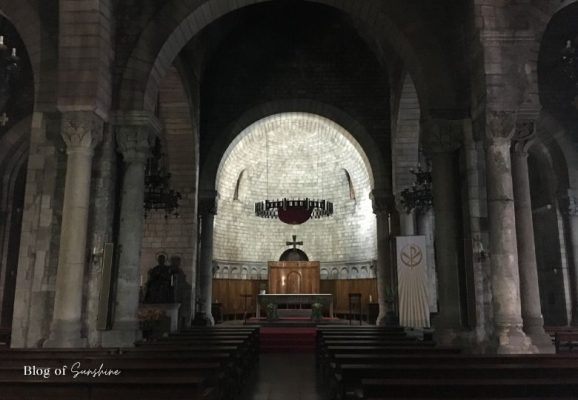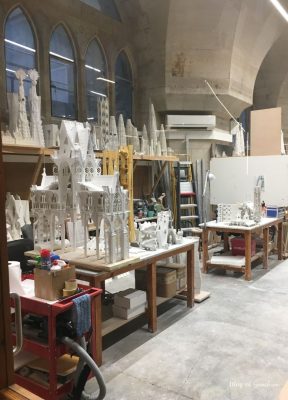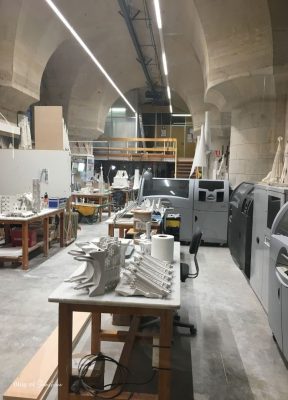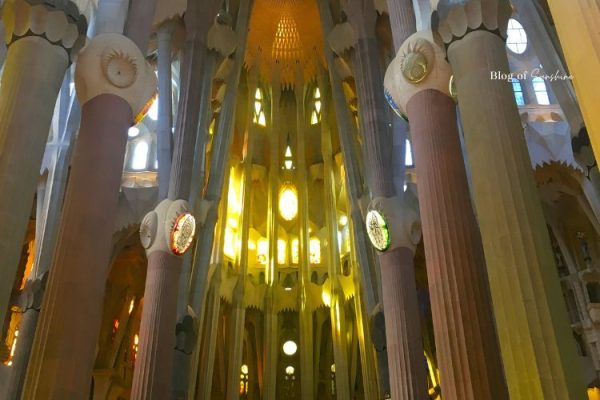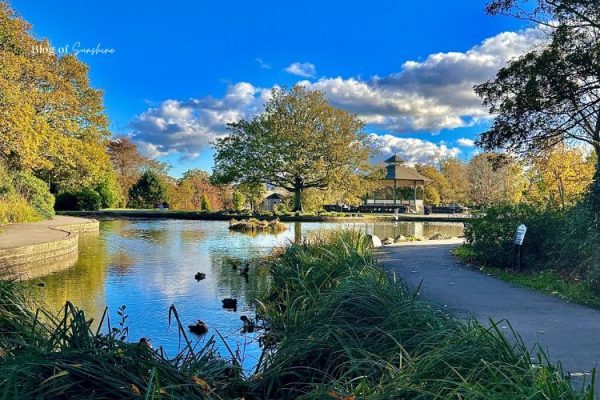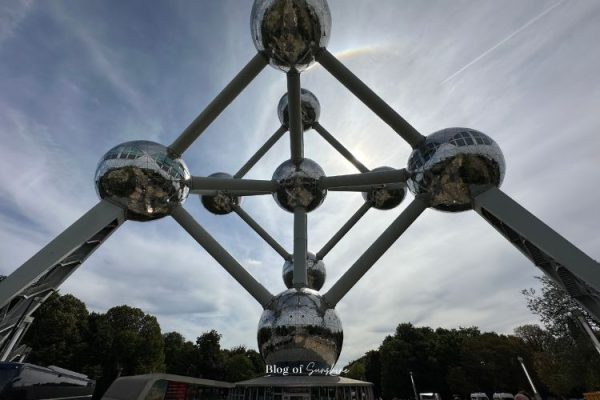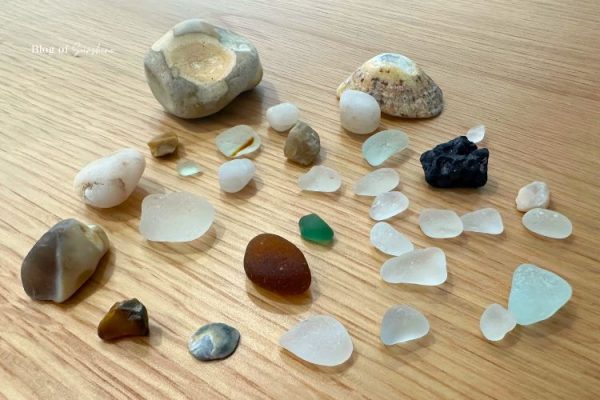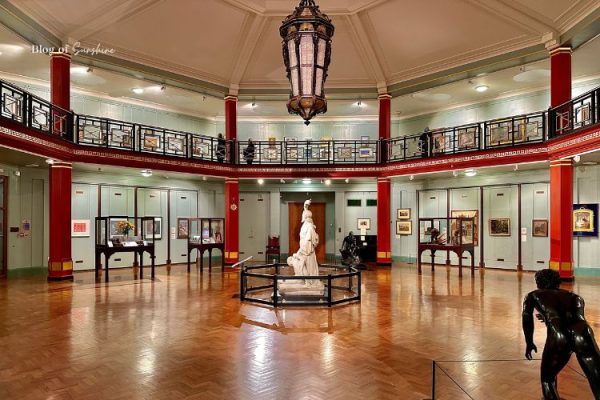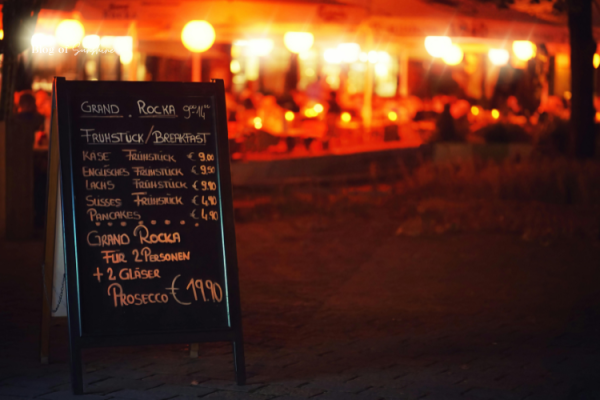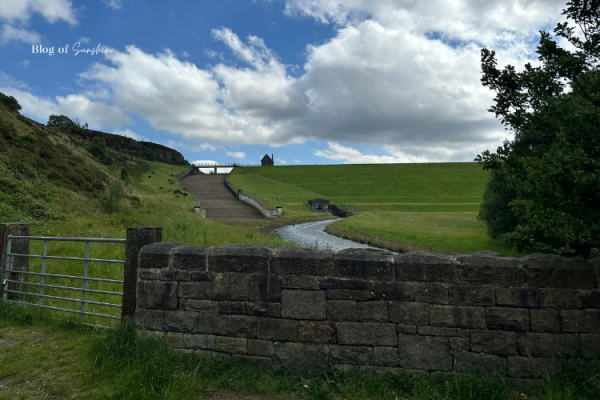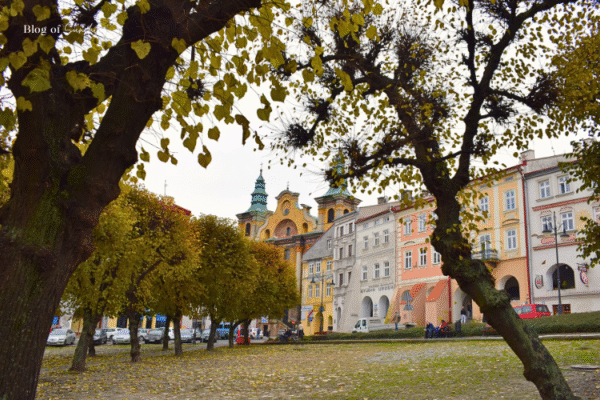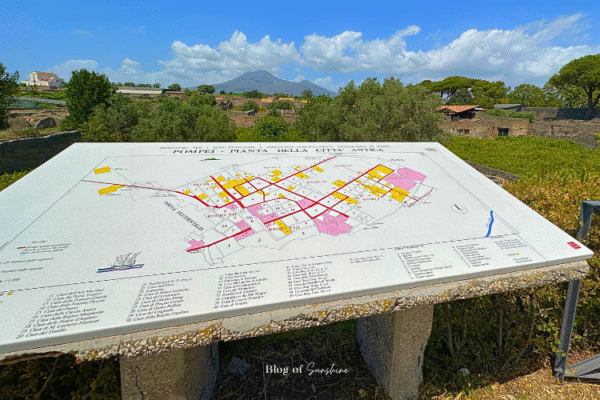Table of Contents
Is the Sagrada Família Worth It?
That’s the question almost every visitor to Barcelona asks, especially when faced with long queues, entry fees, and a city full of other Gaudí masterpieces. But the true answer can’t be found from the street. It’s only when you step inside the Basílica de la Sagrada Família that the magic truly begins.
Sunlight streams through massive stained-glass windows, flooding the vast space with a rainbow of colour. Gaudí didn’t just design a building, he designed an atmosphere, a play of light and architecture that changes by the hour. Whether you’re a photographer, architecture lover, or curious traveler, the interior light show alone makes this one of the most breathtaking spaces in Europe.
In this post, I’ll share exactly why the Sagrada Família is worth visiting, especially for what happens when the light hits just right. Plus, I’ll give you photo tips, best times to visit for lighting, and a closer look at the jaw-dropping details that most people miss.
First Things First: Book Ahead and Skip the Line
Before we talk about stained glass and soaring ceilings, let’s get the practical stuff out of the way, because yes, the Sagrada Família is absolutely worth visiting, but only if you plan ahead.
Don’t Show Up Without a Ticket
The Sagrada Família isn’t just a Barcelona highlight, it’s one of the most visited monuments in all of Europe. That means long lines, crowded time slots, and often, no tickets left at all for walk-ins. If you’re wondering “is Sagrada Família worth it?”, the answer is only yes if you avoid the hours-long queue in the sun.
Book online in advance, ideally from the official website or a trusted ticketing platform. You’ll choose a timed entry slot – and these can sell out days in advance, especially during high season or weekends.
Skip-the-Line Tickets Are Worth It
Spend a little more, save a lot of time. Skip-the-line or fast-track tickets let you breeze past the main queue and head straight to security. Some versions include guided tours or tower access, which are also worth considering depending on your interests.
If you’re short on time or patience (who isn’t while traveling?), this small upgrade makes a big difference.
Best Time Slot to Book
- Morning (9-11 AM): Quieter, soft warm light from the eastern stained glass
- Late afternoon (3-5 PM): Stronger light effects, more dramatic interior colours
- Both are great – just book early to get your preferred time!
Arrive Early, Stay Longer
Even with a timed ticket, you’ll pass through airport-style security. Arrive 15-20 minutes early so you’re not rushed – and so you can enjoy the transition from street to sacred space.
The Exterior: Iconic, Intricate… and Still Under Construction
Before stepping inside, take time to walk the perimeter of the Sagrada Família – it’s a museum in itself. The scale is overwhelming, the detail hypnotic, and even if you’ve seen it in photos, nothing prepares you for how much there is to absorb up close.
Despite being unfinished (construction has stretched since 1882), the basilica stands as one of the most ambitious architectural projects in history. Each side tells a different story, and your journey likely begins at the Passion Facade.
From the sloping ramp to the shadowy sculptural archway, the entrance sets the tone – solemn, striking, and surprisingly modern. It’s the prelude to what’s inside.
The sculptures here don’t look anything like what you’d expect from a Catholic basilica. Josep Subirachs took Gaudí’s vision and flipped it – creating jagged figures with intense emotion. Love it or hate it, it’s unforgettable.
Whether you photograph the entire facade or shoot up toward the towers, the exterior is epic from every angle. But it’s only half the experience.
From the outside, the Sagrada Família feels heavy, raw, and monumental – a place carved more than built. But once you step inside, everything changes. Light floods the space, colours shift, and the basilica breathes.
Up next: the interior – and why it’s what truly makes this place worth visiting.
Afternoon Light and the Passion Facade: Fire, Drama, and Symbolism
One of the most moving things about visiting the Sagrada Família is how light tells a story. Gaudí didn’t just want the basilica to be seen – he wanted it to be felt. And nothing expresses that better than the afternoon light streaming through the Passion Facade’s stained glass windows.
This part of the basilica – the western side – represents the suffering and death of Christ. Fittingly, the windows here are filled with warm, intense colours: reds, oranges, and deep golds. In the late afternoon, the sun hits these windows directly, casting a dramatic glow across the interior.
On 29 September at 15:49, the light was doing exactly what Gaudí intended – turning the space into a sanctuary of fire and emotion.
A Forest of Light: Gaudí’s Columns and Changing Colour
When you look up inside the Sagrada Família, you’re not standing in a typical cathedral – you’re standing in a forest.
Gaudí designed the interior columns to mimic the trunks and branches of trees, branching out as they rise. The ceiling is shaped like a forest canopy. And the light? It behaves like sunlight filtering through leaves – scattering, shifting, warming and cooling depending on the time of day.
This photo captures a rare moment where the warm tones of the afternoon Passion Facade glass meet the cool greens and blues of the opposite Nativity side. The result is a space that feels alive – like you’ve stepped inside a cathedral grown by nature itself.
The Altar and the Ascent: Light, Structure, and Sacred Space
As you move through the interior of the Sagrada Família, the architecture subtly guides your body and mind toward the centre – the altar. Here, the space opens up into a soaring vault of columns and golden light. Gaudí intended this to evoke not just a church, but a living forest reaching toward heaven.
In the central nave, the towering columns feel like trees, branching into a glowing canopy. This isn’t just symbolic – Gaudí wanted visitors to feel surrounded by nature and divinity, grounded and lifted all at once.
Then, just beyond, you encounter the Eucharist chapel, quiet and spare. The cool, blue-green light through the minimalist glass windows brings calm. It’s a contrast to the rich reds and golds around the basilica – a place of stillness and focus amid all the drama of colour and structure.
This duality – drama and peace, ascent and stillness – is what makes the Sagrada Família feel so alive.
Immersed in Colour: When the Light Fills the Basilica
There’s a moment in the late afternoon when the Sagrada Família becomes something completely surreal – when you’re not just looking at stained glass, you’re standing inside it.
As the sun sets over the Passion Facade, the stained-glass windows on the western side of the basilica blaze with reds, oranges, yellows, and even hints of green. The floor glows. The columns reflect fire. And the visitors – whether they’re taking photos or quietly staring upward – become part of the light show.
These two images capture the moment Gaudí spent decades planning: when the light, space, and people all blend. No photo fully does it justice – but this is as close as you can get.
Look Up: The Forest Canopy of Stone and Light
While most cathedrals direct your attention to stained glass and arches, the Sagrada Família invites you to look up – and when you do, you’re standing beneath one of Gaudí’s most breathtaking illusions: a stone forest canopy.
The ceiling is formed from branching columns that split like tree trunks, supporting intricate geometric vaults that mimic the spread of leaves overhead. Skylights scattered throughout the ceiling filter in natural light – not just for beauty, but to enhance the feeling that you’re standing in a sacred forest, not a man-made building.
This design wasn’t just aesthetic. Gaudí believed that nature was the purest expression of the divine, and he built the ceiling to reflect that philosophy. The way light dances off the angular surfaces, the way columns rise and fork like trees – it all feels intentional, calming, and awe-inspiring.
Whether you’re religious or not, it’s impossible not to feel something when standing beneath this canopy. It’s one of the most powerful architectural experiences in the world – and it’s right above your head.
A Hidden Sanctuary: The Crypt Below the Sagrada Família
Most visitors come to the Sagrada Família to see the soaring columns, kaleidoscopic stained glass, and Gaudí’s genius in full sunlight. But few realize there’s a much older, quieter part of the basilica – hidden below.
Beneath the grand structure lies the Crypt of the Sagrada Família, a Romanesque-style chapel built in the late 1800s, and one of the first parts of the basilica to be completed. Stepping into this space is like stepping into another world – cool, dark, and silent, with thick stone columns, rounded arches, and the soft flicker of candlelight.
The crypt is still used for daily Mass and local worship, and it’s not included in the regular tourist circuit – which makes it feel even more sacred. The contrast with the vibrant, light-filled upper basilica is striking. While Gaudí’s nave is meant to inspire awe through nature and light, the crypt offers a moment of calm reflection and intimacy.
It’s also here, in a simple tomb near the altar, that Antoni Gaudí is buried. After dedicating more than 40 years of his life to the basilica, this peaceful space beneath his masterpiece became his final resting place.
If you have time – or manage to visit on a day it’s open – the crypt offers a powerful reminder of the deeper spiritual foundations that lie under the artistry.
Behind the Scenes: Where the Sagrada Família Is Still Being Built
Even after stepping through the astonishing interiors of the Sagrada Família, there’s one final space that brings it all together – and reminds you that this basilica is still under construction.
Tucked away in the lower levels, past the museum exhibits, I came across a glass wall revealing a working design studio. Behind it: rows of white plaster models, detailed 3D-printed parts, half-built prototypes, and the unmistakable feel of active, ongoing creation. This is where the future of the Sagrada Família is being shaped.
Seeing these spaces added a final dimension to the visit – a reminder that what you’re witnessing is a living project. The Sagrada Família isn’t just a masterpiece of the past; it’s still growing, sculpted by hand, machine, and imagination alike.
Is the Sagrada Família worth it? A final few words!
In the end, if you’re still wondering “Is the Sagrada Família worth it?”, standing inside answers that question for you. The exterior is wild and dramatic, the crypt is solemn and still, and the workshop downstairs reminds you this is a living project – but it’s the light inside that stays with you. Afternoon sun pouring through the Passion Facade, floors glowing in oranges and golds, columns turning into trees of colour, and a ceiling that feels more like a forest canopy than a church roof – it’s unlike any other space I’ve ever walked into.
What makes the visit truly special is how all of these layers come together: history, architecture, symbolism, and the constant sense of movement as the light shifts through the day. You’re not just ticking off a famous landmark; you’re stepping into a work of art that is still being made. For me, that’s what makes the Sagrada Família absolutely worth it – not just for the photos, but for the feeling of being inside a place where stone, light, and imagination are all still in progress.
Sagrada Família FAQ – Is the Sagrada Família Worth It? – Tickets, Light & More
Is the Sagrada Família worth it?
Yes, the Sagrada Família is absolutely worth it. The exterior is impressive,
but the real magic is inside, where Gaudí designed the
columns, ceiling and stained glass so that natural light changes the mood
of the basilica throughout the day. If you’re asking
“is Sagrada Família worth it?”, the answer is a clear yes –
especially if you love architecture, photography or unique travel
experiences.
Is it worth going inside the Sagrada Família or is the outside enough?
The outside is iconic, but the interior is what makes the visit unforgettable.
Inside you’ll see tree-like columns, a forest-like ceiling and dramatic
stained-glass light that you simply cannot experience from the street.
If you only see the exterior, you’re missing the best part, so it is
definitely worth paying to go inside.
What is the best time of day to see the light inside the Sagrada Família?
For the most beautiful light inside the Sagrada Família:
- Morning: softer light on the Nativity (east) side, calmer atmosphere.
- Afternoon (around 15:00–17:00): intense reds, oranges and golds through the Passion (west) side – perfect for dramatic photos.
If your priority is photography and stained glass, book an afternoon ticket
when the sun is hitting the Passion Facade.
Do I need to book Sagrada Família tickets in advance?
Yes. The Sagrada Família is one of the busiest attractions in Barcelona and
same-day tickets often sell out, especially in high season and at weekends.
For the best experience:
- Book online in advance from the official site or a trusted partner.
- Choose a timed entry slot that matches the light you want (morning or afternoon).
- Consider a skip-the-line or guided tour to avoid long queues.
How long should I spend inside the Sagrada Família?
Most visitors spend about 1.5 to 2 hours inside the
basilica, but if you enjoy photography, art or architecture you can
easily stay longer. Plan extra time if you:
- Visit the towers.
- Explore the museum and model workshop area.
- Want to sit and simply watch the light change inside the nave.
Is it worth visiting the towers at the Sagrada Família?
The towers are a great add-on if you’re comfortable with heights and narrow
spaces. You’ll get close-up views of the facades and sweeping views over
Barcelona. However, if you’re short on time or budget, prioritise the
interior nave and stained glass first, as that is the most
unique part of the Sagrada Família experience.
Can you visit the crypt in the Sagrada Família?
The crypt, where Antoni Gaudí is buried, is usually used for local church
services and is not always accessible on a standard tourist ticket. When it
is open, you may be able to see it briefly from marked areas. It feels very
different to the main basilica – darker, more traditional and Romanesque
in style.
What is the model workshop area and can visitors see it?
In the museum beneath the basilica, you can look through glass into the
model and 3D design workshop. Here, architects and
designers work with physical models and 3D-printed pieces to plan the
remaining towers and details. You can’t enter the studio, but you can see
how the Sagrada Família is still being designed and built today.
Is the Sagrada Família finished?
No. The Sagrada Família is still under construction, which is why you’ll
see cranes and scaffolding around the towers. Work continues on the main
towers and the Glory Facade. Visiting while it’s unfinished is part of the
charm – you experience a world-famous basilica that is still evolving.
Is there a dress code for visiting the Sagrada Família?
Yes, there is a basic dress code because the Sagrada Família is an active
place of worship. In general:
- Cover shoulders (bring a light scarf if needed).
- Avoid very short shorts or skirts.
- Remove hats inside the nave (except for religious or medical reasons).
Can you take photos inside the Sagrada Família?
Yes, photography is allowed inside the Sagrada Família for personal use,
and the interior is incredibly photogenic. Tripods, flashes and professional
equipment may be restricted, and you should avoid blocking walkways or
disturbing services. For the best photos, use the natural light and give
your camera time to adjust to the contrast.
Is the Sagrada Família worth it just for the light inside?
Many visitors say the light inside the Sagrada Família is the highlight of
their entire trip to Barcelona. Even if you’re not religious, watching the
afternoon sun turn the Passion Facade into a glowing wall of colour is an
unforgettable experience. If you love photography, design, or simply
beautiful spaces, the changing light alone makes the visit worth it.
More Europe Adventures to Explore Next
If the light inside the Sagrada Família has you dreaming of your next trip, don’t rush away just yet. All across Europe I’ve collected moments like this – hidden corners, famous landmarks that really are worth it, language mishaps, cafés with the best people-watching, and easy itineraries you can actually follow. Scroll down to explore more posts from around Europe and let this be the start of planning your next city break, train journey, or sunshine escape.
Is the Sagrada Família Worth It? The Light Inside Says Yes
Wondering is the Sagrada Família Worth It? Step inside and discover how Gaudí’s light-filled masterpiece [...]
ExploreNov
Autumn Walk St Anne’s to Fairhaven Lake: Driftwood & Shells
Enjoy an autumn walk St Anne’s to Fairhaven Lake with driftwood, shells, beach views and [...]
ExploreNov
Autumn Walk Greenhead Park Huddersfield – A Victorian Gem
Enjoy an autumn walk Greenhead Park Huddersfield, a Victorian jewel. Discover fall colour, peaceful paths, [...]
ExploreNov
Atomium Brussels: Is It Worth Visiting? Complete 2025 Guide
Is the Atomium Brussels worth visiting in 2025? Discover pros, cons, insider tips, and everything [...]
ExploreOct
14 Free Things to Do in Brussels in 2025 – Hidden Gems, Views & Culture
Planning a budget-friendly trip to Brussels? This guide reveals 14 free things to do in [...]
ExploreSep
10+ Best Things to Do in Seaham, County Durham – Top Attractions, Landmarks & Coastal Experiences
Discover the best things to do in Seaham, County Durham. From the iconic Tommy statue [...]
ExploreAug
Seaham Hall Beach Sea Glass: When to Go, What to Find, and Top Collecting Tips
Seaham Hall Beach sea glass is famous worldwide. Find out the best times to visit, [...]
ExploreAug
A Day at Cliffe Castle Keighley: What to See, Do, and Know Before You Go
Discover Cliffe Castle Keighley: Explore the Victorian museum, park, café, and everything you need to [...]
ExploreAug
German Dining Etiquette: 7 Essential Table Manners Every Tourist Should Know
Traveling to Germany? Learn the top 7 German dining etiquette tips to avoid tourist mistakes [...]
ExploreJul
Butterley Reservoir Circular Walk Marsden: 210 Steps, Mill Views & 6km Scenic Loop
A 6 km circular walk in Marsden with scenic views, industrial heritage, and 210 iconic [...]
ExploreJul
Is Przemyśl Worth Visiting in 2025? 10 Reasons to Discover This Hidden Polish Gem
Curious about visiting Przemyśl? This 2025 guide shares 10 reasons why this charming Polish city [...]
ExploreJun
Sorrento to Pompeii Train Guide (2025 Timetable + Travel Tips)
Plan your stress-free day trip from Sorrento to Pompeii. This 2025 guide includes train timetables, [...]
ExploreJun

